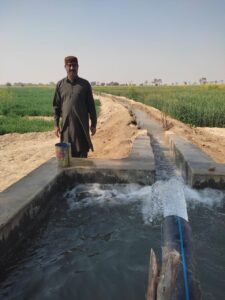 Nestled in the arid expanse of Sindh, the Kachho region of Dadu district has long been at the mercy of unpredictable monsoons and shifting climate patterns. For centuries, the torrents of water flowing from the Kirthar Range’s Baluchistan catchment have shaped the region’s agricultural landscape. While these seasonal rivers bring prosperity, much of the freshwater is often wasted, leaving a trail of devastation before ultimately recharging Manchar Lake.
Nestled in the arid expanse of Sindh, the Kachho region of Dadu district has long been at the mercy of unpredictable monsoons and shifting climate patterns. For centuries, the torrents of water flowing from the Kirthar Range’s Baluchistan catchment have shaped the region’s agricultural landscape. While these seasonal rivers bring prosperity, much of the freshwater is often wasted, leaving a trail of devastation before ultimately recharging Manchar Lake.
For generations, Kachho’s farmers relied on traditional rain-fed agriculture, a method that proved increasingly unsustainable as rising temperatures, erratic rainfall, and declining water tables took their toll. Cropping as a primary livelihood became more difficult, pushing many to the brink of abandoning their ancestral lands.
Ghulam Nabi Laghari, a seasoned grower from UC Drighbala near the Kirthar foothills, shared his struggles: “A few years ago, I tried irrigating my land with a diesel pump, but the high fuel costs and unreliable supply made it an uphill battle. We had to borrow money to cover fuel expenses, paying extra at harvest time just to keep our fields watered.”
For years, most growers in Kachho depended on fuel or electricity-powered irrigation, an increasingly unaffordable practice amid Pakistan’s energy crisis. However, necessity often breeds innovation. With the search for cost-effective and sustainable solutions, climate-affected farmers turned to a transformative technology—solar-powered irrigation.
What began as an experiment quickly evolved into a paradigm shift. More than just a technological upgrade, the transition to solar-powered irrigation was an adaptive response to climate change. With an abundance of sunlight, solar water pumps have become a game-changer for Kachho’s struggling farmers.
 This transition is particularly evident in union councils such as Drighbala, Wahi Pandhi, Tore, and Pat Gul Muhammad—areas situated along Kachho’s sweet-water belt. Here, the legendary Naien Gaaj River replenishes underground reserves, with water tables ranging from 150 to 200 feet deep. As of today, approximately 2,000 to 3,000 solar-powered pumps are in operation, irrigating thousands of previously barren acres.
This transition is particularly evident in union councils such as Drighbala, Wahi Pandhi, Tore, and Pat Gul Muhammad—areas situated along Kachho’s sweet-water belt. Here, the legendary Naien Gaaj River replenishes underground reserves, with water tables ranging from 150 to 200 feet deep. As of today, approximately 2,000 to 3,000 solar-powered pumps are in operation, irrigating thousands of previously barren acres.
Ghulam Nabi Laghari noted, “A solar irrigation pump costs around 20 to 30 lakh rupees, but it is capable of irrigating 20 to 30 acres. With no fuel expenses and minimal maintenance, it’s a long-term investment that pays off.”
The impact of solar irrigation extends beyond cost efficiency. In 2024, Khadim Hussain Babar, a small-scale farmer, installed a solar-powered pump on his family’s land—once left barren due to lack of irrigation. With a steady water supply, Khadim not only revived his fields but also diversified his crops, increasing his income and securing his family’s future.
However, as with any technological advancement, challenges persist. Ghulam Nabi Laghari pointed out a key concern: “If rainfall is scarce, the water table drops, and with too many solar pumps in use, re-boring becomes necessary—a costly affair.”
Despite such challenges, solar irrigation is proving to be a sustainable and climate-friendly solution. By reducing dependence on fossil fuels and electricity, it lowers greenhouse gas emissions while ensuring efficient water use. In a region where food security remains a pressing concern, solar irrigation has enabled year-round crop cultivation, improving household incomes and reducing socio-economic vulnerabilities.
Moreover, increased access to water has revitalized Kachho’s environment. Farmers are now planting more trees and expanding green spaces, fostering a more resilient ecosystem. While financial and technical obstacles remain, Kachho’s farmers have taken a bold step toward self-sufficiency, proving that innovation and adaptability can transform adversity into opportunity.
Solar irrigation is not just about water—it’s about empowerment, resilience, and a sustainable future for Kachho’s farming communities.

Mashallah Boss Great